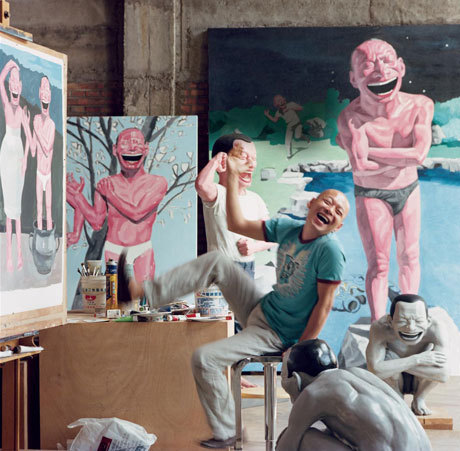Yue Minjun of China is one of my favorite artists, a remarkable bold genius of Asian contemporary art, one of the world's most amazingly and exuberantly creative artists!
(Image below sourced from arabnews.com)
(Image below sourced from en.cafa.com.cn)

(Image below sourced from tumblr.com)

(Picture below of Nicolai Frahm, Yue Minjun and Frank Cohen at the artist's studio in Beijing, China. This image sourced from culture360.org)

(Image below sourced from arrestedmotion.com)

Here's a news report about this remarkably artist:
Million Buck Smiles, Marat’s Empty Bath in Paris Show
By Jorg von Uthmann - Jan 2, 2013 8:00 AM GMT+0800 Bloomberg
Yue Minjun has every reason to laugh. In 2007, one of his paintings sold at Sotheby’s (BID) in London for 2.9 million pounds ($4.47 million).
Laughing faces are the Chinese artist’s trademark. At first, he used to portray friends. Later, he switched to self- portraits with closed eyes and a big grin.
The Fondation Cartier in Paris has organized the first retrospective of his work in Europe, bringing together 40, mostly large-sized paintings and some 100 drawings.
Yue, who was born in 1962, comes from a family of oil workers. Before he took up painting professionally, he worked as an electrician on an offshore oil platform. He now lives in Beijing.
His breakthrough on the international art scene came in 1999, when he was invited to show his work at the Venice Biennale.
Yue’s laughing faces have led some art critics to lump him into the Cynical Realist school which satirizes Socialist Realism, the officially sanctioned style prior to Mao’s death in 1976.
He is, however, reluctant to have his oeuvre pigeonholed, and he maintains a vague position on the political subtext of his paintings.
In an interview printed in the show’s catalog, while discussing the painting “On the Rostrum of Tiananmen,” he is careful not to criticize the 1989 massacre of protesting students by government troops. He only admits to “a profound sense of loss and disillusionment.”
Ai Weiwei
His caution is doubtless one reason why the touchy Chinese government has left him alone while persecuting his more provocative fellow artist Ai Weiwei. Still, it’s obvious that Yue isn’t just an apolitical humorist.On the surface, “The Execution,” the record-setting canvas sold at auction in 2007, (a record now held by Zhang Xiaogang’s painting “Forever Lasting Love” that sold for $10.2 million in 2011 by Sotheby’s Hong Kong) is a parody of Edouard Manet’s “The Execution of Emperor Maximilian,” replacing the emperor and his entourage with four laughing types in underwear.
Yet the red wall in the background, a reference to Beijing’s Forbidden City, tells you that the artist had more in mind than just a spoof.
The same applies to laughing heads cut off from their bodies or cut open to be filled with what looks like red balloons. Could this be a sly allusion to brainwashing?
Hidden Intent
Yue, as usual, remains cautious.
“I wonder,” he says in the interview, “whether my way of painting isn’t interpreted too easily as social criticism. That doesn’t correspond to what I wish to express.”
Whatever he wishes to say, the message isn’t exactly original. We’ve known since the 1923 debut of Franz Lehar’s schmaltzy operetta “The Land of Smiles” that appearances can deceive and that there’s a lot of frustration and despair behind a happy facade.
Fortunately, Yue leaves the beaten track from time to time and ventures on something different.
One of the wittiest pictures in the show is “The Death of Marat,” a copy of Jacques-Louis David’s celebrated canvas. Only one detail is missing -- the hero of the French Revolution in the bath.
“Yue Minjun -- L’Ombre du Fou Rire” is at the Fondation Cartier, 261 Boulevard Raspail, through March 17.
Information: http://www.fondation.cartier.com
(Jorg von Uthmann is a critic for Muse, the arts and leisure section of Bloomberg News. The opinions expressed are his own.)






